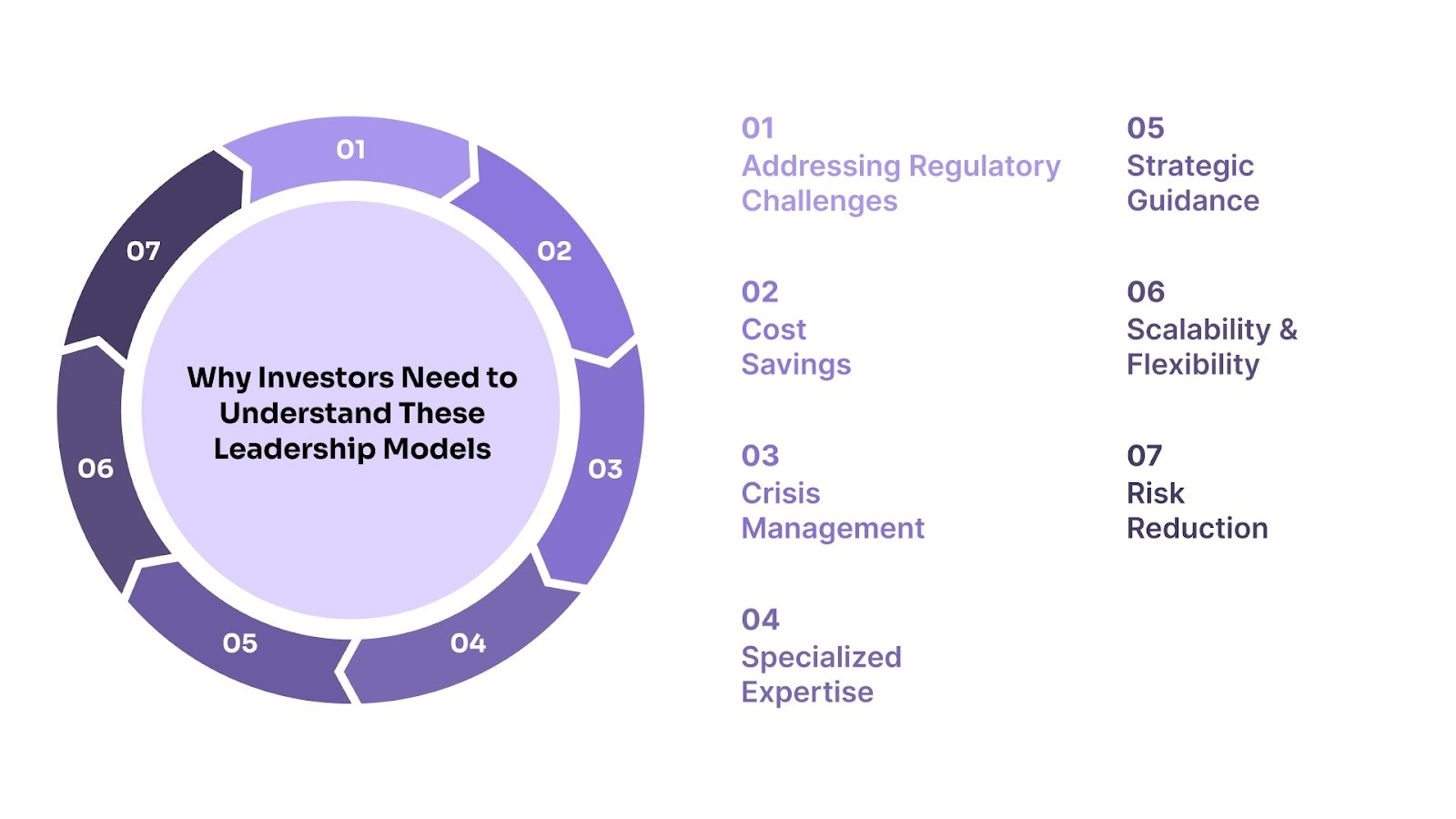Nov 14, 2025
Understanding Fractional vs. Interim Leadership Roles

By Fraxtional LLC

The number of temporary executives worldwide has doubled from 60,000 in 2022 to 110,000 in 2024. This rise highlights how companies are adjusting their leadership strategies. More businesses are turning to flexible leadership roles to meet their needs without long-term commitments.
In sectors like FinTech, banking, and real estate, firms are under pressure to stay compliant and competitive. But finding the right leadership at the right time can be a challenge. Many companies struggle with this balance, especially when hiring full-time executives feels out of reach.
In this blog, we’ll explore the differences between interim and flexible leadership roles. We’ll also discuss how to choose the best option, evaluate leadership effectiveness, and why this matters for investors in today’s market.
TL;DR
- Leadership Models: Interim and flexible leadership provide different solutions for businesses facing short-term or ongoing challenges.
- Interim Leadership: Best for managing crises, transitions, or specific projects requiring full-time expertise and immediate action.
- Flexible Leadership: Ideal for part-time strategic roles, offering specialized skills without long-term commitment.
- Investor Considerations: Investors should evaluate urgency, industry demands, and budget when choosing between interim or flexible leaders.
- Hybrid Approaches: Combining interim and flexible leadership can address both immediate needs and long-term growth.
What Sets Interim and Flexible Leadership Apart?
In business, leadership models are shifting to accommodate the growing need for specialized expertise. Companies are realizing the value of temporary leadership as they face complex challenges in highly regulated sectors.
1. Interim Leadership
Interim leaders are hired for short-term, full-time engagements. They are often experienced executives who manage significant organizational changes or crises. Their main role is to provide stability and leadership during uncertain times.
2. Flexible Leadership
Flexible leaders are typically part-time or fractional leaders who work across multiple companies or projects. They bring expertise for ongoing functions, like regulatory compliance, without the need for a permanent position. These leaders are ideal when a business needs high-level strategy without full-time commitment.
The differences between these two models are significant, and understanding them can be crucial for choosing the right leadership solution. Below is a table summarizing the key characteristics of interim and flexible leadership.
This table provides a clear comparison of the main differences between interim and flexible leadership. By understanding these differences, businesses can make an informed decision based on their unique challenges.
Also Read: Role and Value of an Interim MLRO in Financial Firms
Why Investors Need to Understand These Leadership Models

Understanding when and how to implement interim or flexible leadership models is critical for both companies and investors. These leadership roles can fill crucial gaps without long-term commitments.
Here are some reasons why investors need to understand these models:
- Addressing Regulatory Challenges: Interim and flexible leaders can help companies maintain compliance with complex and shifting regulations, minimizing legal risk.
- Cost Savings: By opting for short-term or part-time leadership, businesses can access high-level expertise without the financial burden of permanent hires.
- Crisis Management: Interim leaders provide stability during periods of disruption or uncertainty, ensuring that the company remains on track.
- Specialized Expertise: Flexible leaders bring in the exact expertise needed for specific functions, enabling businesses to meet regulatory or strategic demands efficiently.
- Strategic Guidance: Interim and flexible leaders offer valuable strategic advice, steering companies toward growth and long-term goals without permanent commitments.
- Scalability and Flexibility: These leadership models allow businesses to scale their operations according to their needs, adjusting leadership resources as necessary.
- Risk Reduction: Temporary leadership helps businesses manage risk during leadership transitions, crisis situations, or periods of change.
These models offer companies a practical way to navigate complex leadership challenges while minimizing costs and risks.
Also Read: Fractional Employment and Its Benefits for the Workforce
Selecting the Ideal Leadership Model Based on Your Business Needs

Choosing the right leadership model is crucial for addressing the unique needs of a business. Both interim and flexible leadership provide specific solutions depending on the challenges a company faces. Deciding which model to adopt requires careful consideration of use-cases, regional factors, and sector-specific demands.
Each leadership model offers distinct advantages based on a company’s situation. Below, we’ll explore key factors to consider when making the decision:
- When to Choose Interim Leadership
- Crisis Management: Interim leaders are ideal for stabilizing operations during leadership transitions, financial difficulties, or regulatory issues.
- Mergers and Acquisitions: In periods of mergers or acquisitions, interim leaders help manage the integration process and ensure smooth transitions.
- Regulatory Audits: Companies undergoing regulatory audits or compliance checks may need an experienced interim leader to oversee these critical processes.
- Geographic Nuances: In global markets, interim leaders can be valuable when dealing with local or regional compliance requirements and operational shifts.
- Sector-Specific Needs: In industries like banking or real estate, interim leaders are often needed to provide immediate expertise during periods of change, such as regulatory shifts.
- When to Choose Flexible Leadership
- Long-Term Strategic Guidance: Flexible leaders can offer ongoing advisory services to help guide businesses toward long-term goals without a full-time commitment.
- Specialized Expertise: These leaders provide highly specialized skills, such as expertise in cybersecurity, regulatory compliance, or financial risk management.
- Expansion into New Markets: When expanding into new regions, flexible leaders can provide the knowledge necessary to enter new markets without a permanent hire.
- Cross-Border Operations: Flexible leadership is ideal for businesses operating in multiple regions where local expertise is required but full-time roles are not needed.
- Sector-Specific Benefits: For industries like FinTech or crypto, flexible leaders offer vital ongoing support in areas such as regulation and cybersecurity, which are crucial for long-term success.
- Hybrid Models
- Combining Interim and Flexible Leadership: In some cases, businesses may benefit from both models. Interim leaders can manage immediate needs, while flexible leaders provide ongoing strategic support.
- Managing Complex Transitions: Companies facing large-scale changes, such as organizational restructuring or rapid market growth, may need a combination of both leadership types.
- Regional and Sector Nuances: Depending on the market and industry, hybrid models can offer tailored solutions that address both urgent and long-term needs.
Choosing between interim and flexible leadership requires understanding the specific needs of your business. By weighing the challenges, sector-specific demands, and regional considerations, companies can make the best decision for their leadership needs.
Whether interim or flexible, our leadership models support your business through transitions and long-term strategies. Learn more!
Key Factors for Investors to Consider in Leadership Selection

Choosing the right leadership model is essential for investors to ensure a company’s growth and stability. The decision between interim and flexible leadership depends on several key factors. Understanding these criteria can help make the best choice for your portfolio company’s needs.
Here are the critical factors investors should consider when evaluating leadership models:
- Urgency of the Leadership Need: Interim leaders are ideal when urgent, full-time leadership is necessary for immediate challenges or crises.
- Scope of Responsibilities: Interim leadership is suited for high-impact roles, while flexible leaders handle specific tasks or strategic functions on a part-time basis.
- Budget and Cost Considerations: Interim leadership may involve higher costs due to full-time commitment, whereas flexible leadership offers a more cost-effective solution over time.
- Regulatory and Industry Demands: In industries like banking or FinTech, interim leaders can guide companies through critical compliance processes or regulatory changes.
- Geographic and Market Considerations: Interim leaders are beneficial for companies with global operations, while flexible leaders offer local expertise for region-specific challenges.
- Long-Term Strategic Support: Flexible leadership is suited for businesses that need ongoing strategic advice or specialized skills but do not require full-time executives.
By evaluating these factors, investors can ensure they choose the right leadership model to address specific business needs effectively.
Also Read: When to Hire a Fractional Compliance Officer
How Investors Can Use Fractional and Interim Leadership Effectively

Investors can take advantage of fractional and interim leadership to fill critical gaps, drive transformation, and accelerate growth. By strategically selecting the right leadership model, they can ensure optimal outcomes for their portfolio companies. Here’s how to approach the process effectively:
- Assess Company Needs: Diagnose leadership gaps by evaluating urgency, scope, and required expertise.
- Match Model to Mission: Choose interim leadership for high-stakes, full-time deployments and fractional leadership for ongoing, advisory roles.
- Focus on Expertise: Prioritize leaders with relevant industry experience and track records of success in similar scenarios.
- Define Budget & ROI: Assess the cost-effectiveness of interim vs. fractional leadership, and ensure clear KPIs are set for performance.
- Align Sector, Geography & Culture: Ensure the leader fits the company’s industry, geographic needs, and internal culture.
- Monitor Performance & Knowledge Transfer: Implement staged reviews and ensure a smooth knowledge transfer for long-term impact.
- Mitigate Common Pitfalls: Avoid scope creep, misalignment, and underutilization by setting clear expectations and empowering leaders.
By following these recommendations, investors can make smarter decisions that maximize value and reduce risks for their portfolio companies.
Conclusion
Choosing the right leadership model is crucial for business success, especially in regulated sectors. Interim and flexible leadership provide specialized expertise for both immediate and long-term needs. Understanding when to use each model helps investors support their portfolio companies through key challenges.
At Fraxtional, we offer a range of leadership services to help businesses meet regulatory demands and strategic goals. From AML compliance to interim CCO and fractional CRO services, our experts are here to guide your business through complex regulatory landscapes.
Contact us today to learn more about how we can assist your business.
FAQs
Interim leaders are often needed in industries facing urgent challenges, such as banking, real estate, and FinTech, where they can address short-term disruptions or compliance issues.
Flexible leaders offer ongoing strategic advice and specialized knowledge without the need for a full-time commitment, helping businesses manage specific functions like compliance or financial oversight.
Flexible leadership is ideal for businesses needing long-term strategic support, specialized expertise, or guidance in areas like regulatory compliance, without requiring a full-time leader.
Yes, some businesses may benefit from both models—using interim leaders for urgent needs and flexible leaders for continuous support on specialized or strategic tasks.
Investors should assess the company’s specific needs, whether it's crisis management or ongoing strategic guidance, and evaluate the leadership's expertise, fit within the company culture, and budget considerations.
blogs
Don’t miss these
Let’s Get Started
Ready to Strengthen Your Compliance Program?
Take the next step towards expert compliance solutions. Connect with us today.




